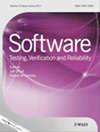Localizing software performance regressions in web applications by comparing execution timelines
IF 1.2
4区 计算机科学
Q3 COMPUTER SCIENCE, SOFTWARE ENGINEERING
引用次数: 2
Abstract
A performance regression in software is defined as an increase in an application step's response time as a result of code changes. Detecting such regressions can be done using profiling tools; however, investigating their root cause is a mostly‐manual and time‐consuming task. This statement holds true especially when comparing execution timelines, which are dynamic function call trees augmented with response time data; these timelines are compared to find the performance regression‐causes – the lowest‐level function calls that regressed during execution. When done manually, these comparisons often require the investigator to analyze thousands of function call nodes. Further, performing these comparisons on web applications is challenging due to JavaScript's asynchronous and event‐driven model, which introduce noise in the timelines. In response, we propose a design – Zam – that automatically compares execution timelines collected from web applications, to identify performance regression‐causes. Our approach uses a hybrid node matching algorithm that recursively attempts to find the longest common subsequence in each call tree level, then aggregates multiple comparisons' results to eliminate noise. Our evaluation of Zam on 10 web applications indicates that it can identify performance regression‐causes with a path recall of 100% and a path precision of 96%, while performing comparisons in under a minute on average. We also demonstrate the real‐world applicability of Zam, which has been used to successfully complete performance investigations by the performance and reliability team in SAP.通过比较执行时间来本地化web应用程序中的软件性能退化
软件中的性能回归被定义为由于代码更改而导致应用程序步骤响应时间的增加。检测这种回归可以使用分析工具来完成;然而,调查其根本原因主要是一项手动且耗时的任务。这句话尤其适用于比较执行时间线,它是动态函数调用树和响应时间数据的增强;将这些时间线进行比较,找出性能退化的原因——在执行过程中退化的最低级别函数调用。当手工完成时,这些比较通常需要研究人员分析数千个函数调用节点。此外,由于JavaScript的异步和事件驱动模型,在web应用程序上执行这些比较是具有挑战性的,这在时间轴上引入了噪声。作为回应,我们提出了一种设计——Zam——它可以自动比较从web应用程序收集的执行时间线,以识别性能退化的原因。我们的方法使用混合节点匹配算法,递归地尝试在每个调用树级别找到最长公共子序列,然后聚合多次比较的结果以消除噪声。我们在10个web应用程序上对Zam的评估表明,它可以以100%的路径召回率和96%的路径精度识别性能回归原因,而平均在一分钟内执行比较。我们还展示了Zam在现实世界中的适用性,它已被SAP的性能和可靠性团队成功地用于完成性能调查。
本文章由计算机程序翻译,如有差异,请以英文原文为准。
求助全文
约1分钟内获得全文
求助全文
来源期刊

Software Testing Verification & Reliability
工程技术-计算机:软件工程
CiteScore
3.70
自引率
0.00%
发文量
34
审稿时长
>12 weeks
期刊介绍:
The journal is the premier outlet for research results on the subjects of testing, verification and reliability. Readers will find useful research on issues pertaining to building better software and evaluating it.
The journal is unique in its emphasis on theoretical foundations and applications to real-world software development. The balance of theory, empirical work, and practical applications provide readers with better techniques for testing, verifying and improving the reliability of software.
The journal targets researchers, practitioners, educators and students that have a vested interest in results generated by high-quality testing, verification and reliability modeling and evaluation of software. Topics of special interest include, but are not limited to:
-New criteria for software testing and verification
-Application of existing software testing and verification techniques to new types of software, including web applications, web services, embedded software, aspect-oriented software, and software architectures
-Model based testing
-Formal verification techniques such as model-checking
-Comparison of testing and verification techniques
-Measurement of and metrics for testing, verification and reliability
-Industrial experience with cutting edge techniques
-Descriptions and evaluations of commercial and open-source software testing tools
-Reliability modeling, measurement and application
-Testing and verification of software security
-Automated test data generation
-Process issues and methods
-Non-functional testing
 求助内容:
求助内容: 应助结果提醒方式:
应助结果提醒方式:


